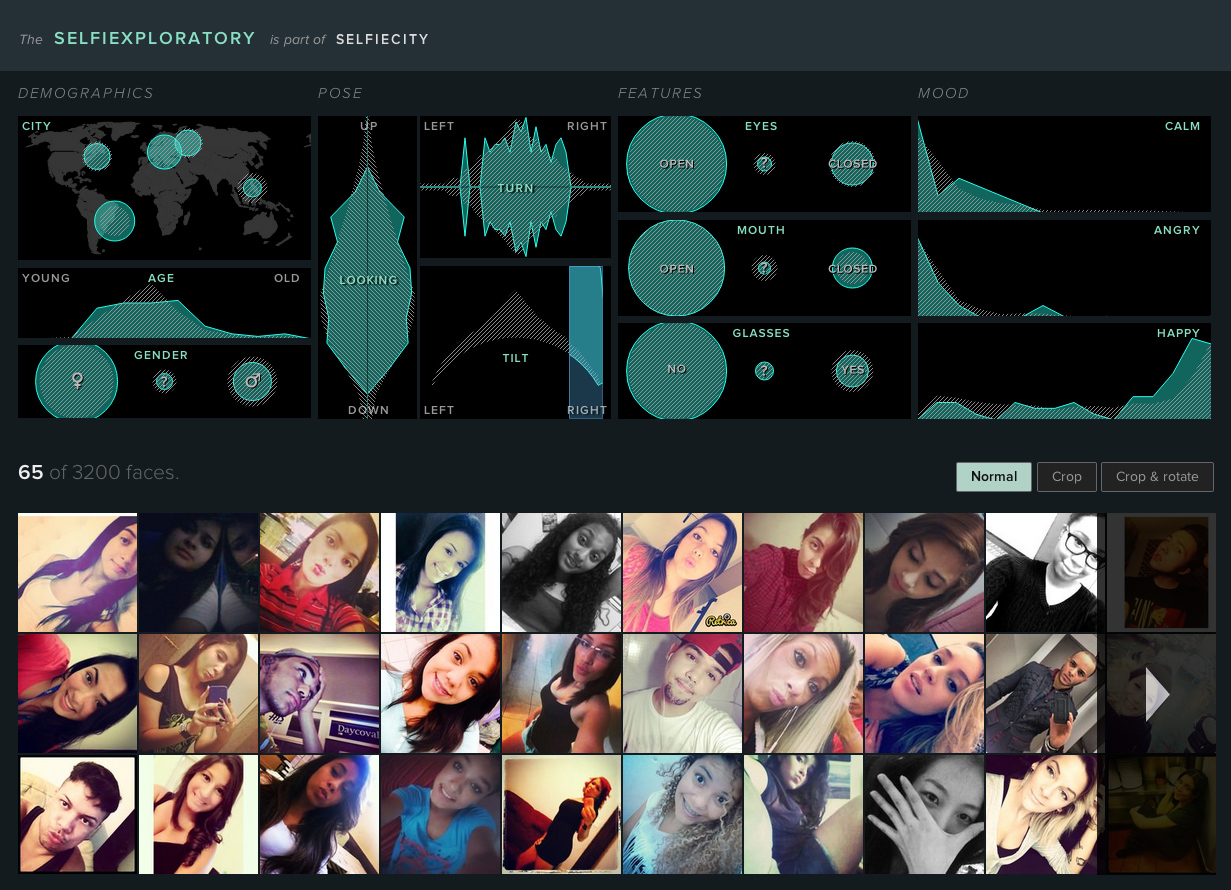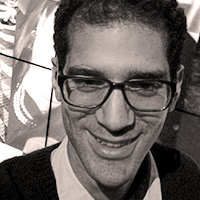selfiecity
Investigating the style of self-portraits (selfies) in five cities across the world.
Selfiecity investigates selfies using a mix of theoretic, artistic and quantitative methods:
- We present our findings about the demographics of people taking selfies, their poses and expressions.
- Rich media visualizations (imageplots) assemble thousands of photos to reveal interesting patterns.
- The interactive selfiexploratory allows you to navigate the whole set of 3200 photos.
- Finally, theoretical essays discuss selfies in the history of photography, the functions of images in social media, and methods and dataset.
Imageplots
Poses
Each city has a different style when it comes to selfies. Compare yourself:
In these grids, we have arranged the photos horizontally by head tilt; the vertical axis shows you if people look up or down.
In addition, we can crop and rotate the photos to center on the faces:

Gender and age profiles per city
Case by case inspection of photos can reveal a lot of detail, but it is difficult to quantify the patterns observed.
"Is it just me, or do Sao Paulo women actually tilt their heads more? Do New Yorkers or Berliners look older?"
In order to answer these questions, and supplement our rudimentary automatic face analysis with human judgment, we had thousands of photos inspected by Mechanical Turk workers, who estimated age and gender of the people on the photos. Here are the results:

Smile distributions by gender and city
We can also the determine the facial expressions of the selfies in a city — who smiles the most, and who has more reserved looks?

the selfiexploratory
Experiment with all the data we collected.
Do angry people tilt their heads more strongly? And what is a characteristic mood for people in Moscow? Find out!
→ Launch
Data collection and analysis
This project is based on a unique dataset we compiled by analysing tens of thousands of images from each city, both through automatic image analysis and human judgement.
How we collected and filtered the data
To locate selfies photos, we randomly selected 120,000 photos (20,000-30,000 photos per city) from a total of 656'000 images we collected on Instagram. 2-4 Amazon’s Mechanical Turk workers tagged each photo. For these, we asked Mechanical Turk workers the simple question "Does this photo shows a single selfie"?
We then selected top 1000 photos for each city (i.e., photos which at least 2 workers tagged as a single person selfie).
We submitted these photos to Mechanical Turk again, asking three "master workers" (i.e. more skilled workers) not only to verify that a photo shows a single selfie, but also to guess the age and gender of the person.
On the resulting set of selfie images, we ran automatic face analysis, supplying us with algorithmic estimations of eye, nose and mouth positions, the degrees of different emotional expressions, etc.
As the final step, one or two members of the project team examined all these photos manually. While most photos were tagged correctly, we found some mistakes. We wanted to keep the data size the same (to make visualizations comparable), so our final set contains 640 selfie photos for every city.
Our main findings
People take less selfies than often assumed
Depending on the city, only 3-5% of images we analysed were actually selfies.
Significantly more women
In every city we analyzed, there are significantly more women selfies than men selfies (from 1.3 times as many in Bangkok to 1.9 times more in Berlin). Moscow is a strong outlier - here, we have 4.6 times more female than male selfies!
A young people's sport? Indeed.
Most people in our photos are pretty young (23.7 estimated median age). Bangkok is the youngest city (21.0), whereas NYC is the oldest (25.3). Men's average age is higher than that of women in every city. Surprisingly, more older men (30-) post selfies on Instagram than women.
Bangkok, Sao Paulo are all smiles
Our mood analysis revealed that you can find lots of smiling faces in Bangkok (0.68 average smile score) and Sao Paulo (0.64). People taking selfies in Moscow smile the least (only 0.53 on the smile score scale).
Women strike more extreme poses, especially in Sao Paulo
Women's selfies show more expressive poses; for instance, the average amount of head tilt is 50% higher than for men: (12.3° vs. 8.2°). Sao Paulo is most extreme - there, the average head tilt for females is 16.9°!














